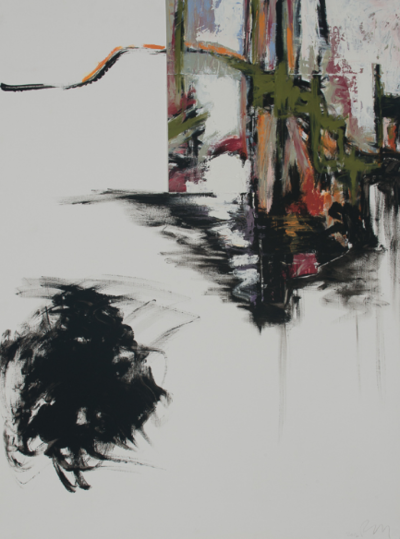Ruth Mordecai, an Interview with the Artist

Ruth Mordecai, No. 4, 2016, collage and acrylic on paper, 11 x 11″. All images courtesy Trident Gallery.
By Olivia J. Kiers
Rocky Neck artist Ruth Mordecai’s current show at Trident Gallery in Gloucester, MA (Ruth Mordecai: Works on Paper, through September 5) reveals the wonder inherent in Mordecai’s highly tactile explorations of simple, abstracted symbols. Under Mordecai’s eye (and palette knife), even commonplace objects like a brown paper bag can take on a new, primal force. Art New England interviewed Mordecai for a few insights into her personal approach to abstraction.
Art New England: This show has a simple title: Ruth Mordecai: Works on Paper. Why have you chosen to work on paper? Why does this medium appeal to you?
Ruth Mordecai: I use a really heavy, 300 lb-weight British paper, and I like to work on the wall, on matte board so there’s a smooth surface. The paper usually comes in a 40 x 60” sized-piece. I often start off making a painting that size, but could end up cutting it, making it a different size if that is where the work wants to be… Those scraps aren’t wasted either; I can reuse them in collage. There is freedom with paper.
ANE: Are there any new themes or techniques that make an appearance in this show, or is this a continuation for you?
RM: In some ways, it’s a continuation. There were some works from the Container Series in my 2014 show [Ruth Mordecai: New Works on Paper, also at Trident Gallery]. That series continues to be a summary, or a collection of symbols, of sculptural forms like containers. There are some new appearances… the shape of a paper bag, with that rectangular paper handle, is incorporated into a number of pieces. That brown paper is something I love.

Ruth Mordecai, Homage to Matisse, 2016, collage, oil and graphite on paper, 60 x 42″.
ANE: One of the works on view is titled Homage to Matisse. Can you comment on Matisse’s influence? Are there other artists you think about as you work?
RM: That Matisse piece holds a really important place for me. When I was beginning in art school, I was thrilled by Matisse’s Back Series, four backs which were created in clay and cast in bronze. They go from figural to abstraction—that last piece, the most abstracted one, was the one that my collage was a take-off on. It’s my version of it… Matisse is an inspiration to me, not because of color, but because of his sculptural forms and drawings.
David Smith is another [influence]. There’s a found-object piece—I don’t remember the name—welded like a huge landscape, which is very free. And his drawings are an inspiration as well. They are very gestural. The third influence is probably Joan Snyder, who is so free with materials. She charted a new place entirely.
ANE: Does your vocabulary of motifs hold specific meanings for you?
RM: They always would. You work in things that you feel in your gut, and for some reason have a personal meaning, but you hope they transcend the personal and reach universality. That’s the hope.
My work is very tactile, a very hands-on collage, with paint applied by hand (I wear rubber gloves) or with a palette knife or oil stick. It’s not neat and clean! … For me, the whole process of abstraction is very primal. You either relate to it, or you don’t.

Ruth Mordecai, Landscape/Black Line, 2016, collage, oil and acrylic on paper, 39.5 x 29.5″.
ANE: You used to work in Boston’s Fort Point district for many years before moving your studio to Rocky Neck. Did that move change the way you work at all?
RM: Well, that’s a good question. When I moved, I said to an artist friend in Rocky Neck that I didn’t think that being here would make a difference. I was in Fort Point for 25 years with a 1,500-square-foot space, participating in a wonderful artist collaboration… and I essentially worked inside. Here, I have 600 square feet, still working at a large scale on the walls. But eventually I wanted to make a shift from that clay grey and plaster white… I wanted to go out and paint a landscape.
For a while, I got excited about sunrises, going out at five in the morning to watch them and paint. Looking back, I don’t know how I did it! But it was thrilling. What has stayed with me is that for a while there seemed to be a landscape line that crept into my work over time. There is one piece in my current show that has one, Landscape/Black Line. I also felt influenced to bring in more color, but I’m just not a colorist.
ANE: Are there any final thoughts you would like to share?
RM: I’d like to say that I try to stay away from explanations, even from the word “universal.” This gradual move I had after art school into abstraction was just a natural progression of discovering my own personal visual language. It’s also a return to something primal, which is almost better left without an explanation.
